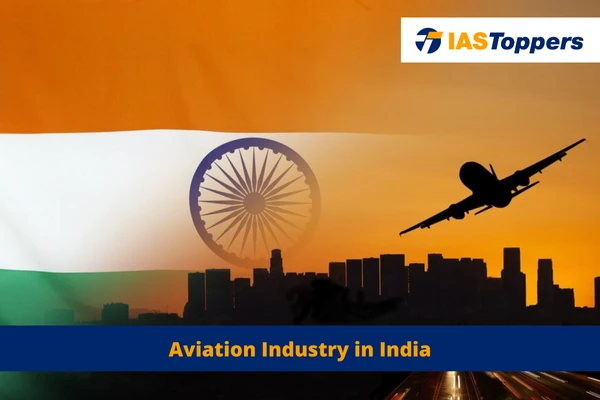The Aviation Industry in India is a vital component of the nation’s economic framework, has witnessed exponential growth in recent years, making it one of the fastest-growing aviation markets in the world. In this article, you will learn about status of Aviation Industry of India, challenges faced by them, Government Initiatives, way forward, etc.
This article will provide key insights for GS Paper- III Economy of UPSC IAS Exam.
Table of Content
- Aviation Industry of India
- Challenges faced by Aviation Industry in India
- Government Initiatives for Aviation Industry in India
- Way forward
- Conclusion
- Frequently Asked Questions
Aviation Industry of India
- India’s aviation industry encompasses all elements of civil aviation, including airlines, airports, aircraft manufacturing, aviation services, and regulatory bodies.
- It can be classified into-
- Scheduled air transport service: It includes domestic and international airlines.
- Non-scheduled air transport service: It includes charter operators and air taxi operators.
- Air cargo service: It includes air transportation of cargo and mail.
- India has emerged as the world’s third–largest domestic aviation market.
- By 2023, its airports are expected to manage 1 billion trips annually.
Challenges faced by Aviation Industry in India
- Infrastructure Constraints
- Airport Congestion: Major airports like Mumbai and Delhi suffer from severe congestion, causing delays and inefficiencies.
- Limited Regional Connectivity: While major cities have good air connectivity, smaller towns often lack sufficient airport infrastructure and flights.
- Cutthroat Pricing: To attract passengers, airlines in India often dramatically slashes the ticket prices, making it challenging to balance the earning and spendings, especially when operational costs remain high.
- High Operating Costs
- High taxes on Aviation Turbine Fuel (ATF) and airport charges increase operational expenses.
- In some states, taxes on jet fuel can be as high as 30%, making short routes unprofitable for smaller airlines.
- Pilot Shortages
- Recruiting and retaining experienced pilots is a challenge, leading to disruptions and higher labour costs.
- With orders for over 1,100 new aircraft, there is a demand for thousands of flight crew members.
- Pilot training in India is expensive, with airlines often adding extra charges for cadet pilots.
- Security Threats
- Apart from terrorism and hijacking, cyber threats to aviation infrastructure pose significant security concerns, potentially disrupting operations and compromising passenger data.
- Other Issues
- The management of medical standards by Indian Air Force doctors has led to the grounding of many civilian pilots.
- Operating flying training centres is challenging, increased by officials who enforces outdated regulations.
Government Initiatives for Aviation Industry in India
- Reduced GST (Goods and Services Tax) rate: It was reduced to 5% from 18% for domestic Maintenance, Repair and Overhaul (MRO) services.
- Regional Connectivity Scheme (RCS) UDAN (Ude Desh ka Aam Nagrik) Scheme: It provides affordable air travel to the citizens by promoting air connectivity to unserved and underserved airports in Tier-II and Tier-III cities.
- Krishi UDAN 2.0.: It aims for better integration and optimization of Agri-harvesting and air transportation and contributing to Agri-value chain sustainability and resilience under different and dynamic conditions.
- National Civil Aviation Policy 2016: It aims to enhance affordability and connectivity and promotes ease of doing business, deregulation, simplified procedures, and e-governance.
- National Air Sport Policy 2022: It lays out the vision of making India as one of the top sports nations by 2030, by providing a safe, affordable, accessible, enjoyable, and sustainable air sports ecosystem in India.
- Up to 100% FDI is permitted under the automatic route in: Non-scheduled air transport services, Helicopter services, seaplanes; MRO (maintenance and repair organizations), flying training institutes, Ground Handling Services subject to sectoral regulations & security clearance, etc.
Way forward
- Eco-Friendly Initiatives
- Incentivize Electric and Hybrid Aircraft: Promote the development & use of electric or hybrid aircraft for short-haul flights to reduce emissions & lower operational costs.
- Sustainable Aviation Fuels (SAFs): Encourage the adoption of SAFs and carbon offset programs to lessen the aviation industry’s environmental impact.
- Digital Twins for Maintenance
- Implement Digital Twin Technology: Create virtual replicas of aircraft to enable predictive maintenance, reducing downtime and improving operational efficiency.
- Public-Private Partnerships (PPPs)
- Collaborate on Airport Infrastructure: Foster cooperation between the government and private sector to co-invest in airport infrastructure development, ensuring world-class facilities.
- Reducing the Pilot Gap
- Subsidized Pilot Training Programs: Establish affordable pilot training programs in collaboration with aviation schools and academies to make pilot training more accessible to aspiring aviators.
- Aviation Tourism Packages
- Innovative Tourism Collaborations: Collaborate with the tourism industry to create aviation-based tourism packages. These can include scenic flights, adventure experiences, aerial photography tours, etc.
Conclusion
The Aviation Industry in India, characterized by rapid growth and increasing relevance both domestically and internationally, serves as a critical component of the nation’s economic infrastructure. It not only enhances connectivity across India’s vast geography but also significantly boosts tourism and trade, fostering broader economic growth.
However, the industry faces challenges such as high operational costs, regulatory hurdles, and infrastructural constraints. Addressing these challenges effectively requires concerted efforts from both the government and private sectors to enhance operational efficiency, expand infrastructure, and implement favorable policies.
Ref: Source-1
| Other Articles in Economy | |
| Sectors of Indian Economy | Monetary Aggregates |
| Debt Recovery Tribunal | Laffer Curve |
| Kuznets Curve | External Commercial Borrowing |
FAQs (Frequently Asked Questions)
How big is India’s aviation industry?
The India Aviation Market size is estimated at 13.89 billion USD in 2024.
What is India’s rank in aviation market?
India is currently world’s 3rd largest civil aviation market.
Who controls aviation in India?
The Ministry of Civil Aviation is responsible for formulation of national policies and programmes for the development and regulation of the Civil Aviation sector in the country.




